HVAC drawings are key for putting in heating, ventilating, and air-conditioning systems. They’re needed in homes and businesses. Following these mechanical drawing guidelines is vital. It makes sure the work fits the rules and the building’s plan. Knowing HVAC drafting tips helps technicians understand easily. And it makes installing smoothly. Learning about HVAC system diagrams makes you an expert. It helps you make sure your work is accurate and follows the rules.
Key Takeaways
- HVAC drawings detail the specific requirements for heating, air conditioning, and ventilation installations.
- Understanding mechanical drawing guidelines ensures technical precision and code compliance.
- Accurate HVAC drafting tips streamline installation processes and reduce errors.
- System diagrams include essential notes, legends, symbols, and scales.
- Comprehensive HVAC plans are vital for both maintenance and troubleshooting.
Importance of HVAC Drawings
HVAC drawings are key for installing heating, ventilation, and air-conditioning systems efficiently and safely. They show where to place equipment and how to manage airflow. These drawings are vital for building and maintaining structures. They are used by many, like contractors, engineers, and architects.
Ensuring Compliance with Building Codes
HVAC layout plans are crucial for following building codes. They must meet rules for safety and the environment. By obeying these laws, you prevent problems and keep people safe. Following codes also helps you get needed permits faster.
Facilitating Accurate Installations
Good HVAC drawings help with putting things in the right spot. They show exactly where to install each part. This lowers the chance of mistakes. Thus, it saves money on fixes and makes the HVAC work well.
Enhancing Maintenance and Troubleshooting
These diagrams also make fixing and caring for systems easier. They help workers find and solve issues fast. With clear diagrams, spotting problems is quick. This speeds up repairs, keeping the system in good shape.
Using detailed plans from start to finish makes buildings run better and safely. It’s all about careful planning and design. This ensures the HVAC system lasts long and works well. In the end, everyone benefits from such well-thought-out plans.
Understanding HVAC System Components
Knowing the parts of HVAC systems helps keep indoor spaces comfy. They have three key parts: heating, ventilation, and air conditioning units. Each one is important for staying warm, breathing good air, and feeling cool inside.
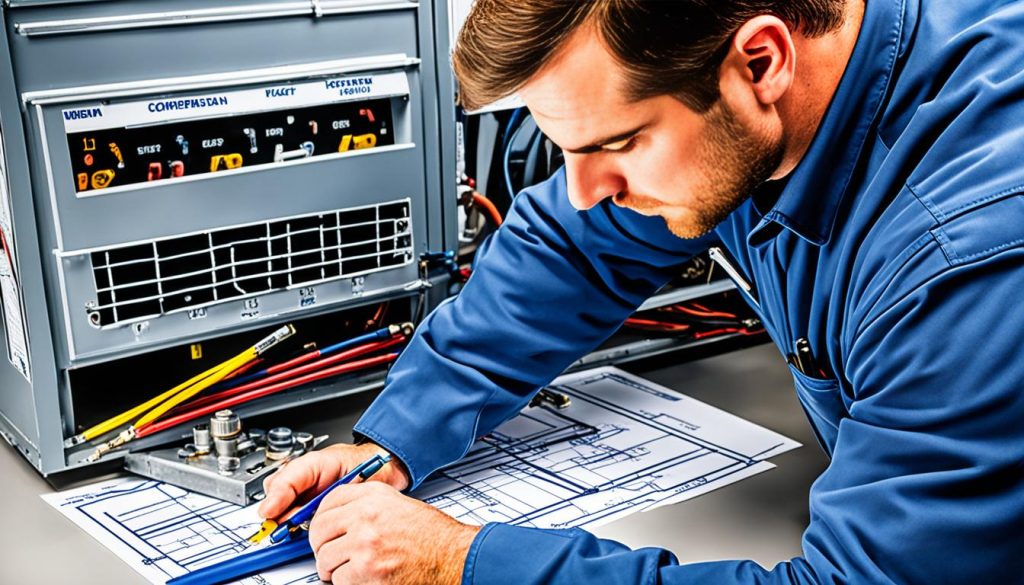
Heating Components
Heating sections make indoor areas warm. They include boilers, heat pumps, and electric heaters. These parts are crucial for keeping things cozy. It’s important to place them right for good warmth without wasting energy.
Ventilation Systems
Ventilation is all about swapping indoor and outdoor air. It removes bad smells, dirt, and extra moisture. Plus, it brings in fresh air for better breathing. Adding a good ventilation system is key for clean air and a comfortable space.
Air Conditioning Units
Air conditioners cool and manage moisture in indoor areas. They use thermostats, humidifiers, and different cooling methods. Knowing how air conditioning works with the other parts is key. This is how we ensure both comfort and clean air anytime, all year round.
To understand HVAC, we need to see how all the elements work together. This builds a nice, healthy indoor place for everyone. Mastering this helps make homes, offices, and other spaces the best they can be.
Key Elements of HVAC Plans
Knowing the important parts of HVAC plans is crucial. It helps in setting up and keeping HVAC systems working well. We’ll look at what makes these plans good and complete.
General Notes and Legends
General notes in HVAC plans give needed steps and job rules. They help technicians and provide drafting advice. Legends explain symbols and codes in drawings. This makes it easy to understand ducts and control devices.
Abbreviations and Symbols
Abbreviations and symbols are vital in HVAC plans. They turn hard parts into clear info, making plans easier to use. Examples are CFM (Cubic Feet per Minute) and VAV (Variable Air Volume). Symbols show the jobs and types of gear in the designs.
Schematic Diagrams
Schematic drawings are key in HVAC plans. They give a big picture of how systems work. These show how parts work together. Using tips in these drawings helps fix problems and ensures work is precise.
Types of HVAC Drawings
It’s key to know the various kinds of HVAC drawings for a successful system design and install. They show how system parts connect and work together well.
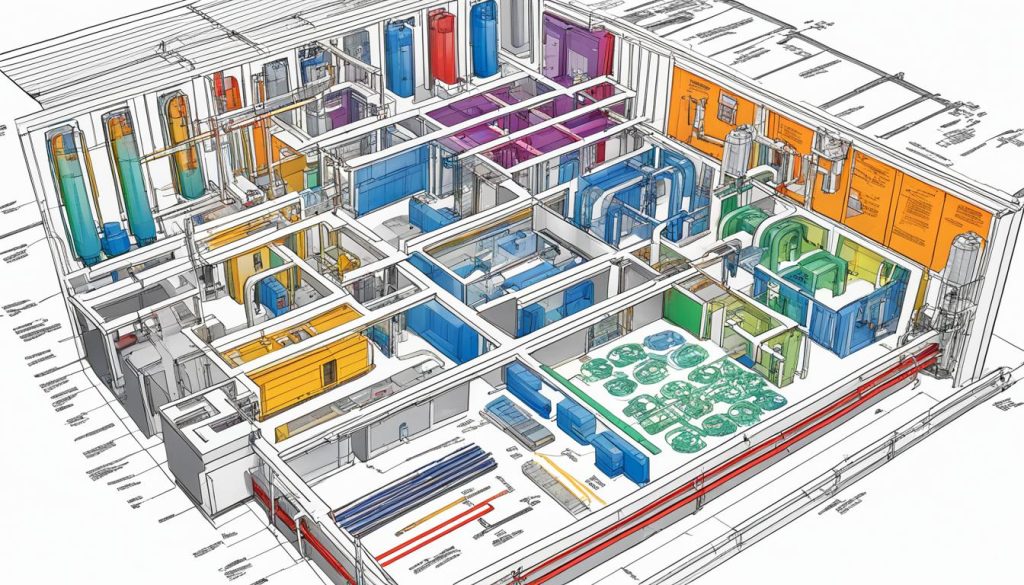
Schematic Drawings
In schematic drawings, you see the flow of energy and air within the HVAC. They help in understanding how system parts work together. But, they don’t show the size details. These drawings focus on the entire system’s operation.
Plan Drawings
Plan drawings give a bird’s-eye view. They are like maps, showing HVAC part layouts from above. This type explains parts’ placement, directions, and connections in great detail.
Elevation Drawings
Elevation drawings offer a system view from various heights. They highlight how HVAC parts are set up vertically in a building. This helps check if the system’s layout fits the building’s structure well.
Isometric Drawings
Isometric drawings show the HVAC system’s 3D look on 2D paper. They let you check the spaces and connections of system parts. This view is great for understanding the system’s layout in tight spaces.
How to Read HVAC Blueprints
Reading HVAC blueprints is essential for HVAC work. It requires knowing scales, symbols, and abbreviations. This helps understand drawings of HVAC systems better.
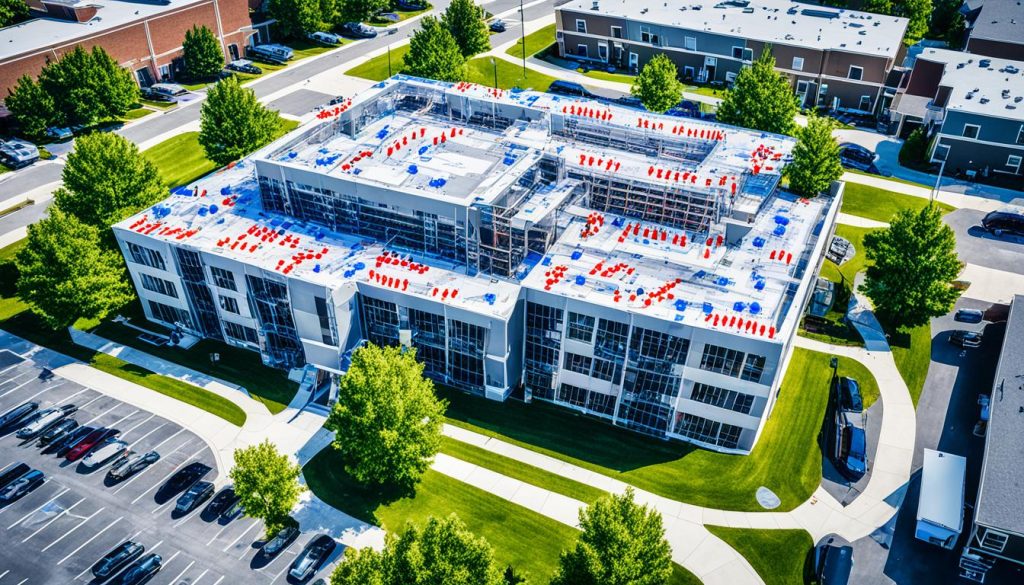
Understanding Scale and Measurements
The scale in HVAC maps shows the size of parts correctly. Knowing this helps avoid mistakes. It makes sure systems fit perfectly in buildings.
Interpreting Symbols and Annotations
Symbols and notes help explain HVAC maps. They show types of equipment and how air moves. Color-coding helps to see different parts clearly. Notes also give specific advice for placing things correctly.
Common Abbreviations
There are many abbreviations used in HVAC maps. Some often used ones are:
- CFM – Cubic Feet per Minute
- BTU – British Thermal Unit
- VAV – Variable Air Volume
- AHU – Air Handling Unit
- RTU – Roof Top Unit
It’s important to know these abbreviations. They help read and talk about HVAC maps accurately. This is useful for working on them or keeping them running well.
Knowing how to read HVAC diagrams well is crucial in the HVAC field. It leads to better installations and system operations. This understanding improves how we work with HVAC plans overall.
How HVAC Drawings Improve Installation Efficiency
HVAC drawings are key to making installations better. They show the details and where each part goes. This makes projects finish faster and with fewer mistakes. So, using these drawings helps installers avoid errors and do a great job.
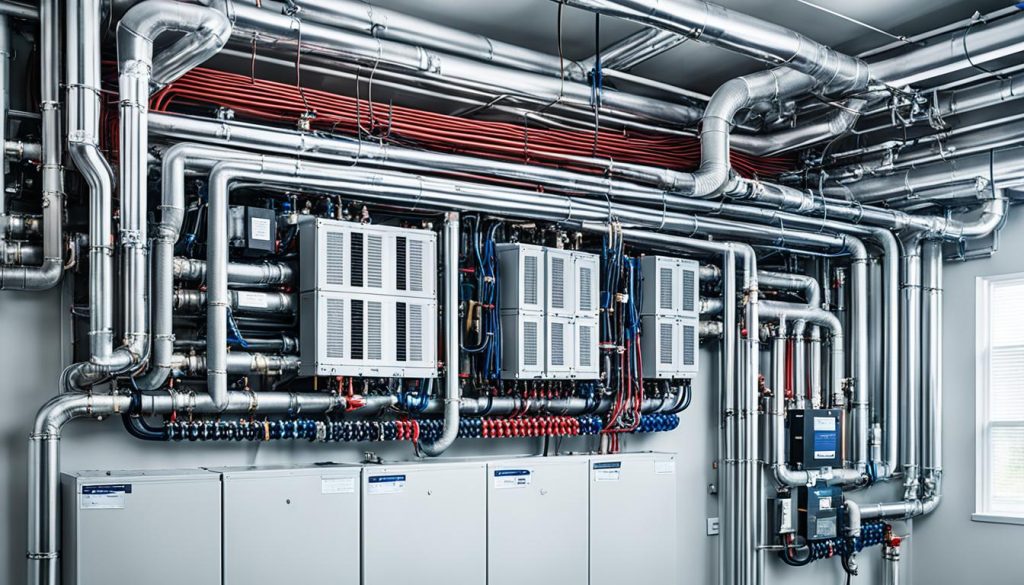
Reducing Errors
HVAC drawings help cut down on mistakes. They show exactly how the heating and cooling systems should be set up. With these clear plans, installers know just where everything goes. This leads to a better working HVAC system.
Streamlining the Installation Process
These drawings also make the set-up process smoother. Installers get a roadmap to follow. It helps them see the big picture and do their tasks in the right order. This method speeds up the work and makes the HVAC system work even better.
| Benefits of HVAC Drawings | Impact on Installation |
|---|---|
| Detailed Schematics | Provide clear guidance and reduce errors. |
| Specific Component Placement | Ensures accurate and efficient installations. |
| Process Streamlining | Improves the predictability and speed of installations. |
| Error Minimization | Enhances overall system performance by reducing costly corrections. |
Creating Accurate HVAC Layout Plans
Good HVAC layout plans start by knowing what the building needs. You work with architects to make sure the plans are top-notch. Focusing on saving energy helps the system run well and last a long time.
Site Analysis
Looking closely at a site builds the groundwork for HVAC designs. This checks the building’s features like size and which way it faces. It picks the best spots for the HVAC stuff to make sure everything works right.
Coordination with Architects
Teamwork with architects is key in creating HVAC plans. Together, you make sure the systems and the building work together well. This makes the building look good, work right, and save energy.
Ensuring Energy Efficiency
Making HVAC systems that use less power is very important now. Choosing the right equipment and design helps the system work well and save energy. This means lower bills and helping the planet at the same time.
| Key Consideration | Details |
|---|---|
| Site Analysis | Evaluates structural attributes, identifies optimal placements, and ensures ventilation requirements are met. |
| Coordination with Architects | Seamlessly integrates HVAC systems with the building design and enhances functional and aesthetic elements. |
| Energy Efficiency | Selects systems/components that consume less energy, reducing costs and supporting sustainability. |
Benefits of Digital HVAC Drawings
Moving to digital HVAC drawings has changed how we design and keep up with HVAC systems. It brings unmatched accuracy and chances for working together.
Utilizing BIM Technology
Building Information Modeling (BIM) helps in HVAC by making detailed and accurate plans. These fit well with other building systems. BIM makes digital HVAC plans better, helping experts to spot and fix issues early. This makes work go smoother.
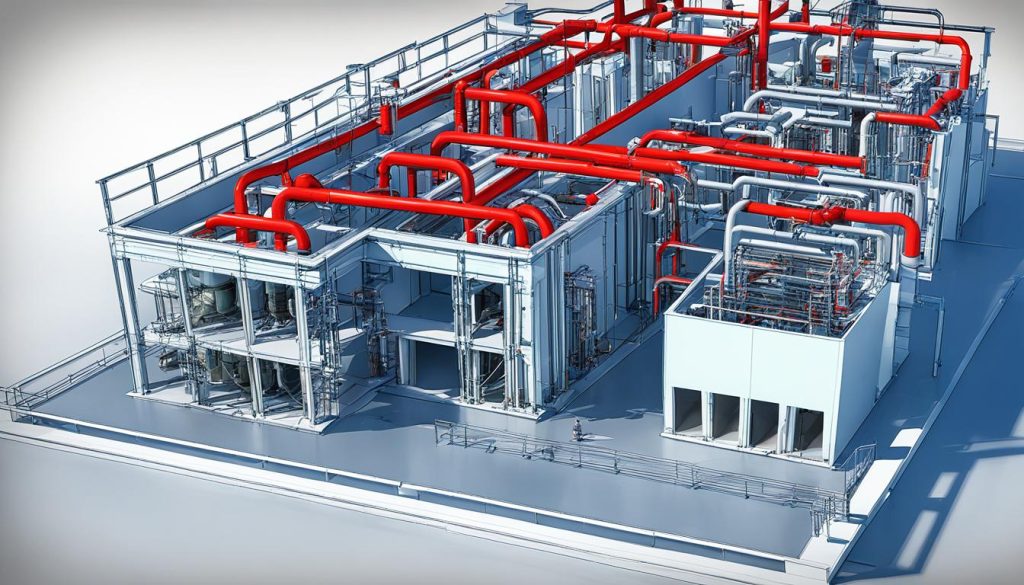
Using BIM in HVAC allows for quick updates and team efforts. When a design is changed, it updates all related plans right away. This lowers mistakes and makes sure everyone follows the building rules carefully.
BIM also helps with a project’s life after it’s done. It keeps everything working right and cuts repair costs by spotting problems early.
Incorporating IoT for Predictive Maintenance
IoT is changing HVAC by focusing on spotting issues before they get big. It uses sensors to watch HVAC systems all the time. This helps find and fix problems before they become serious.
IoT makes HVAC systems last longer and work better. It lets managers and techs deal with wear fast, which keeps everything energy-efficient. This tech lowers the time a system’s not working and cuts repair expenses.
| Aspect | BIM in HVAC | IoT in HVAC Systems |
|---|---|---|
| Function | Enhances design accuracy and coordination | Enables real-time monitoring and predictive maintenance |
| Benefits | Streamlined workflow, immediate updates, compliance maintenance | Extended system longevity, reduced downtime, optimized performance |
Common Symbols and Their Meanings
In HVAC drawings, it’s key to know common symbols for the right setup and care. These symbols make it easier to read air conditioning blueprints. They help with heating and cooling schematics and ductwork design.
Temperature Controls
Temperature control symbols show tools that adjust the room’s feel. They are crucial for getting the perfect warmth and coolness in different places of a structure.
Humidity Control
Humidity control symbols stand for gear that handles inside moisture. Understanding these symbols well is important for keeping the air comfy and safe. It stops problems like mold and being too dry.
Ductwork Symbols
Ductwork symbols describe the layout of air channels in a building. They show how air moves, making sure conditioned air reaches everywhere efficiently. Knowing these symbols helps with accurate setups based on the ductwork design.
Conclusion
The HVAC Drawing Guide shows how important it is to make detailed mechanical diagrams. These diagrams are for heating, ventilation, and air conditioning systems. By learning to make them, you help ensure HVAC systems work well in homes and businesses.
You learn about each part of the system, like ductwork and diffusers. And you learn what kinds of drawings to use. This helps you create systems that save energy and meet the rules.
Today, we have new tech like Building Information Modeling (BIM) and the Internet of Things (IoT). These make designing HVAC systems much better. They help work with other designers, make systems work better, and know when systems need care.
Knowing about mechanical diagrams makes you better at your job. It helps you handle tough projects. And using new technology means HVAC systems work even better, save more energy, and follow the rules. This guide is key for improving your skills and setting high standards for HVAC work.

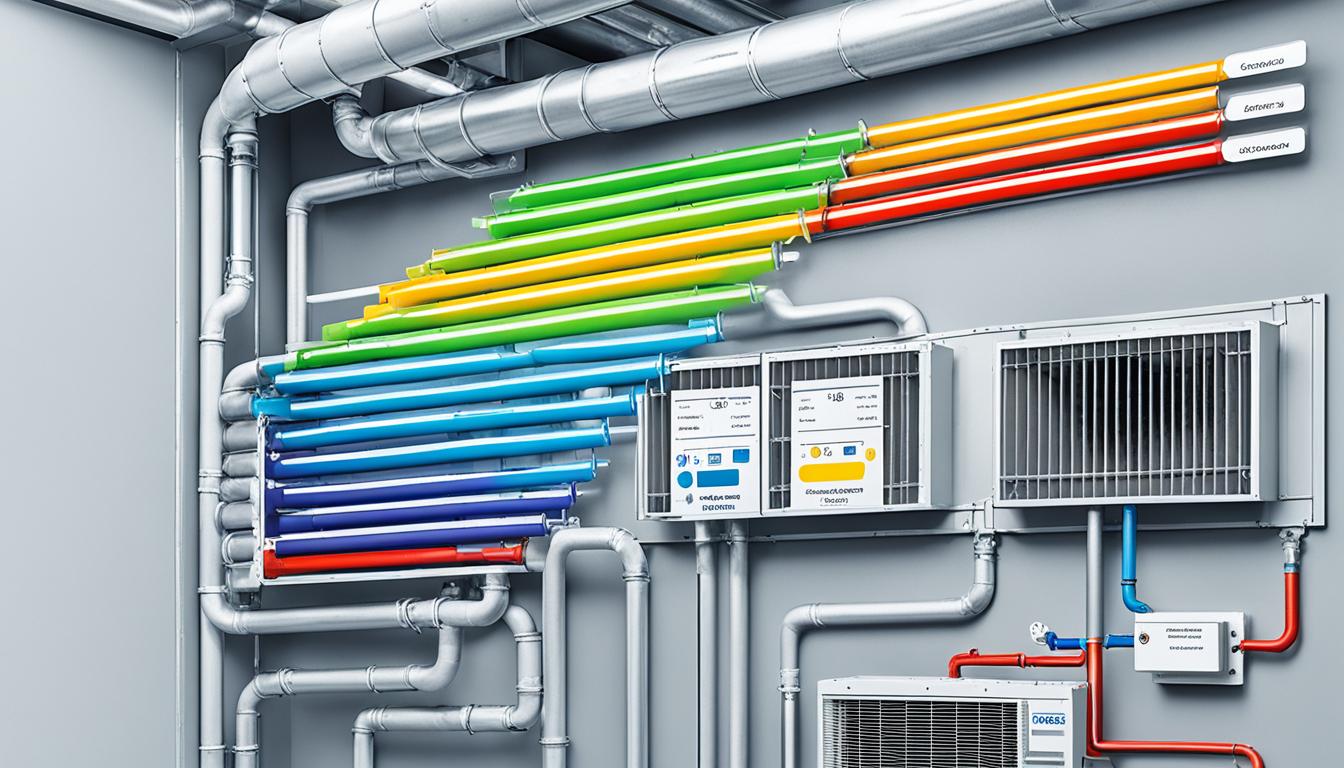



0 Comments